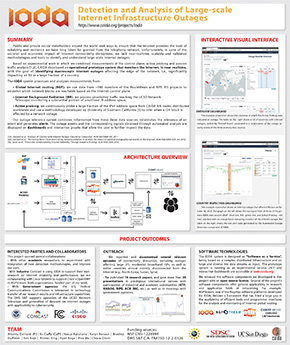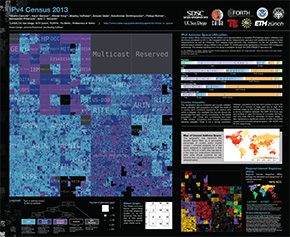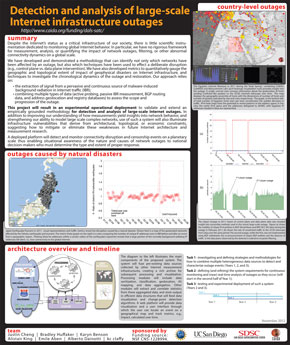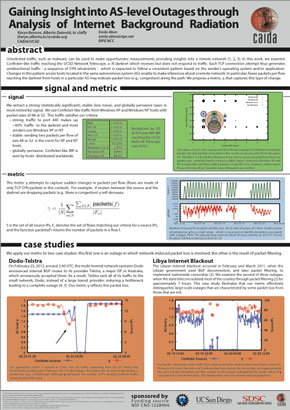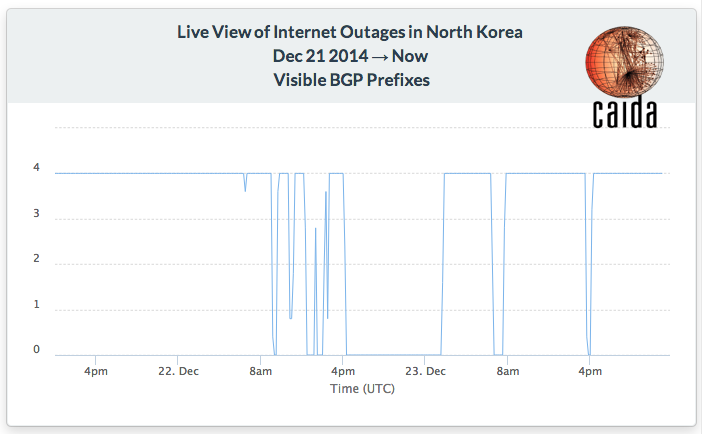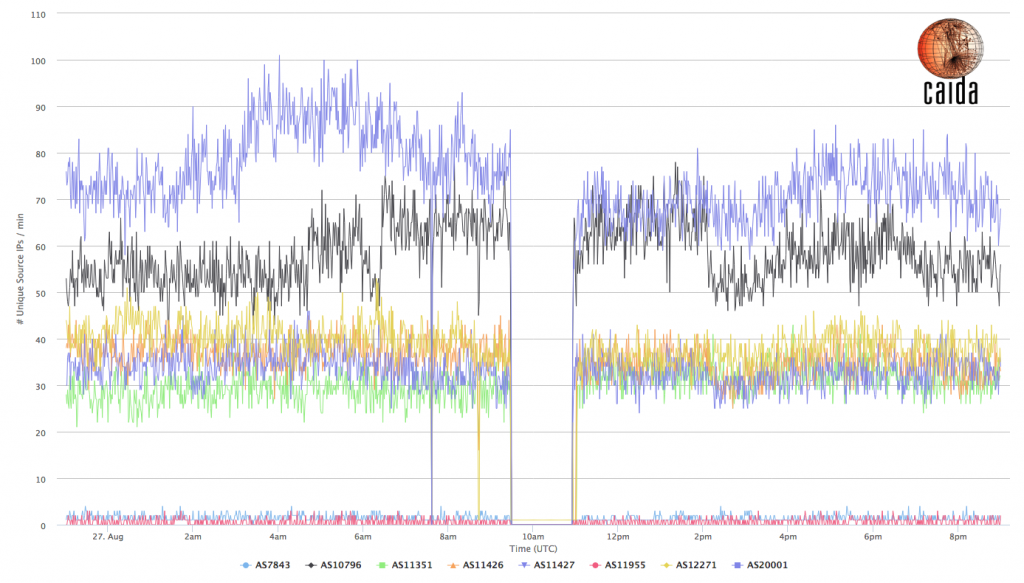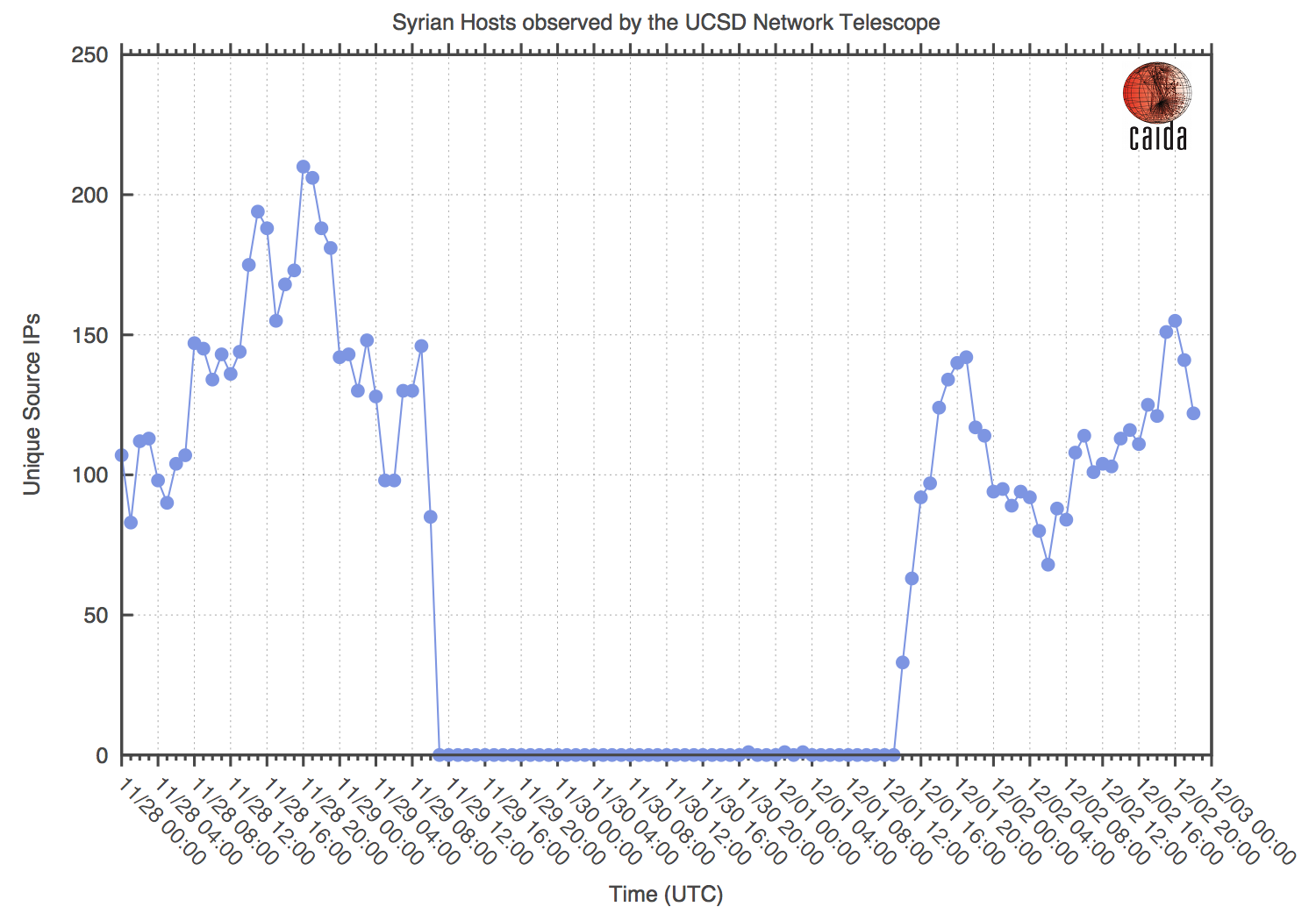Overview
The IODA system processes and analyzes measurements from:
- Global Internet routing (BGP): we use data from ~500 monitors participating in the RouteViews and RIPE RIS projects to establish which network blocks are reachable based on the Internet control plane.
- Internet Background Radiation: we process unsolicited traffic reaching the UCSD Network Telescope monitoring an unutilized /8 address block.
- Active probing: we continuously probe a large fraction of the (routable) IPv4 address space from several CAIDA Ark nodes distributed worldwide and use a methodology developed by University of Southern California to infer when a /24 block is affected by a network outage.
Our outage inference system combines information from these three data sources, establishes the relevance of an event and generates alerts. The outage events and the corresponding signals obtained through automated analysis are displayed on dashboards and interactive graphs that allow the user to further inspect the data.
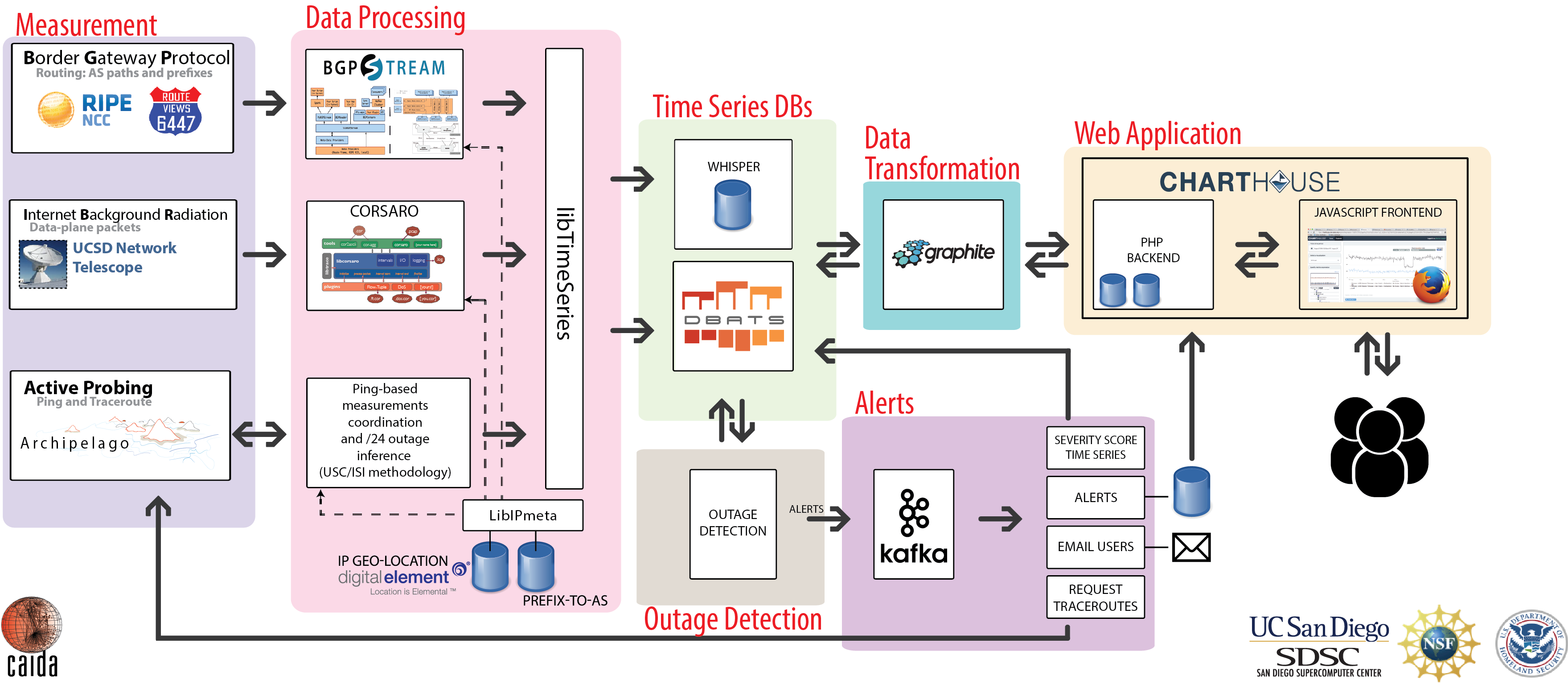
A high-level view of the architecture of IODA
Interactive Visual Interface
The IODA system is designed as "Software as a Service", being based on a complex distributed infrastructure and on large and diverse live data streams taken as input. The prototype system is running as an experimental service 24/7 and high-level interactive dashboards are accessible at:
Other examples of IODA visualizations are:
- Live view of the reachability of BGP prefixes geolocated to North Korea (last 7 days), and linked view of December 2014 outages in North Korea.
- Animation showing the evolution of the RouteViews and RIPE RIS BGP measurement infrastructure since 2001.
- An experimental visualization of the impact of the Sandy hurricane (2012) using data from active measurements from Planet Lab nodes carried out by the University of Maryland.
"Transition to Practice" (TTP) - Transitioning research results to practice
Collaboration with Industry
Public Safety
Open-source Software
We released the software components we developed in this project with an open source license. Several of the project's software components offer general applicablity to research and applicative fields of networking. | BGPStream is an open-source software framework for live and historical BGP data analysis, supporting scientific research, operational monitoring, and post-event analysis. Although BGP is a crucial operational component of the Internet infrastructure, and is the subject of research in the areas of Internet performance, security, topology, protocols, economics, etc., there is no efficient way of processing large amounts of distributed and/or live BGP measurement data. BGPStream fills this gap, enabling efficient investigation of events, rapid prototyping, and building complex tools and large-scale monitoring applications (e.g., detection of connectivity disruptions or BGP hijacking attacks). |
 | DBATS is a high performance time series database engine optimized for inserting/updating values for many series simultaneously. DBATS can easily sustain write speeds of more than 1.6 million values per second, and CAIDA has used DBATS databases with more than 40 million distinct series. |
| libtimeseries | libtimeseries is a C library that provides a high-performance abstraction layer for efficiently writing to time series databases. It is optimized for writing values for many time series simultaneously. |
| Corsaro | Corsaro is a software suite for performing large-scale analysis of trace data. It was specifically designed to be used with passive traces captured by darknets, but the overall structure is generic enough to be used with any type of passive trace data. Corsaro enables IODA's processing of IBR captured at darknets to provide time series for outage detection and analysis. |
Presentations
- IODA-NP: Internet Outage Detection and Analysis, DHS S&T Cybersecurity and Innovation Showcase, Mar 2019
- How to find correlated Internet failures, Passive and Active Measurement Conference (PAM), Mar 2019
- Who shuts down the Internet and why?, Internet Measurement And Political Science Workshop (IMAPS), Sep 2018
- IODA-NP: Multi-source Realtime Detection of Macroscopic Internet Connectivity Disruption, DHS S&T PARIDINE Kick-off Meeting, Aug 2018
- Science of Internet Security: Technology and Experimental Research, Applied Network Measurement Science PI meeting, Apr 2018
- Mapping our Way to a More Secure Internet, Internet Initiative Japan (IIJ), Nov 2017
- Internet Outages: Detection & Analysis, Center for Network Systems (CNS) Research Review, Oct 2017
- IODA - Internet Outages: Detection & Analysis, Workshop on Active Internet Measurements (AIMS), Mar 2017
- IODA - Internet Outages: Detection & Analysis, San Diego Supercomputer Center, Feb 2017
- BGPStream, ACM Internet Measurement Conference (IMC), Nov 2016
- BGPStream 2016, Roma Tre University, Jun 2016
- Leveraging Internet Background Radiation for Opportunistic Network Analysis, UC San Diego Thesis Defense, Jun 2016
- BGPStream: a framework for historical analysis and real-time monitoring of BGP data, Workshop on Active Internet Measurements (AIMS) and the North American Network Operators' Group (NANOG), Feb 2016
- BGPStream: a framework for historical analysis and real-time monitoring of BGP data, mPlane Workshop, Nov 2015
- Measuring and Monitoring BGP, Internet Engineering Task Force (IETF), Nov 2015
- Leveraging Internet Background Radiation for Opportunistic Network Analysis, Internet Measurement Conference (IMC), Oct 2015.
- BGPStream, ACM Internet Measurement Conference (IMC), Oct 2015
- Lost in Space: Improving Inference of IPv4 Address Space Utilization, IRTF Workshop on Research and Applications of Internet Measurements (RAIM), Oct 2015
- BGPStream - An Open Source Framework for Live/Historical BGP Data Analysis, RIPE Meeting, May 2015
- IODA - Internet Outages: Detection & Analysis, DHS National Cybersecurity and Communications Integration Center (NCICC), Apr 2015
- BGPstream, Workshop on Active Internet Measurements (AIMS), Mar 2015
- IODA - Internet Outages: Detection & Analysis, Federal Communications Commission (FCC), Mar 2015
- Measuring and Characterizing IPv6 Router Availability, Passive and Active Measurement Conference (PAM), Mar 2015
- Monitoring Large-scale Internet Outages, Federal Communications Commission (FCC), Jun 2013
- CAIDA Research Overview, Network Mapping and Measurement Conference (NMMC), May 2013
- CAIDA Research Overview, Cisco Nerd Lunch, Apr 2013
- Gaining Insight into AS-level Outages through Analysis of Internet Background Radiation, Traffic Monitoring and Analysis Workshop (TMA), Apr 2013
- Lessons Learned by "Measuring" the Internet During/After the Sandy Storm, FCC Workshop on Network Resiliency, Feb 2013
- Toward Realtime Visualization of Garbage, ISMA Workshop on Active Internet Measurements (AIMS), Feb 2013
- A Coordinated View of Large-Scale Internet Events, Workshop on Internet Visualization (WIV), Nov 2012
- Analysis of Internet-wide Probing using Darknets, BADGERS, Oct 2012
- Extracting Benefit from Harm: Using Malware Pollution to Analyze the Impact of Political and Geophysical Events on the Internet, ACM SIGCOMM, Aug 2012
- Analysis of Country-wide Internet Outages Caused by Censorship, Internet Engineering Task Force (IETF), Jul 2012
Posters
Publications
- Blink: Fast Connectivity Recovery Entirely in the Data Plane, USENIX Symposium on Networked Systems Design and Implementation (NSDI), Feb 2019
- How to find correlated Internet failures, Passive and Active Measurement Conference (PAM), Mar 2019
- SWIFT: Predictive Fast Reroute, ACM SIGCOMM, Aug 2017.
- BGPStream: a software framework for live and historical BGP data analysis, Internet Measurement Conference (IMC), Nov 2016
Awarded the IRTF Applied Networking Research Prize 2017 - Lost in Space: Improving Inference of IPv4 Address Space Utilization, IEEE Journal on Selected Areas in Communications (JSAC), Jun 2016
- Leveraging Internet Background Radiation for Opportunistic Network Analysis, Internet Measurement Conference (IMC), Oct 2015
- Measuring and Characterizing IPv6 Router Availability, Passive and Active Network Measurement Workshop (PAM), Mar 2015
- Analysis of Country-wide Internet Outages Caused by Censorship, IEEE/ACM Transactions on Networking, Dec 2014
- Uncovering Network Tarpits with Degreaser, Annual Computer Security Applications Conference (ACSAC), Dec 2014
- A Coordinated View of the Temporal Evolution of Large-scale Internet Events, Computing, Jan 2014
- Estimating Internet address space usage through passive measurements, ACM SIGCOMM Computer Communication Review (CCR), Jan 2014
- Gaining Insight into AS-level Outages through Analysis of Internet Background Radiation, Traffic Monitoring and Analysis Workshop (TMA), Apr 2013
- Extracting benefit from harm: using malware pollution to analyze the impact of political and geophysical events on the Internet, ACM SIGCOMM Computer Communication Review (CCR), Jan 2012
Awarded as one of top-three papers in ACM SIGCOMM Computer Communication Review in 2012 and presented at SIGCOMM 2012 - Analysis of Country-wide Internet Outages Caused by Censorship, Internet Measurement Conference (IMC), Nov 2011
Awarded the IRTF Applied Networking Research Prize 2012
Blog Entries
Press coverage
- "Garbage In, Info Out", Communications of the ACM Article
- Nick Clayton, "Internet Background Radiation Reveals Disasters and Censorship", The Wall Street Journal TECH Blog
- Douglas Perry, "Internet Junk Traffic Used to Uncover Censorship", Tom's Guide, March 11, 2012
- Alberto Dainotti was awarded the Applied Networking Research Prize at IETF-84 for his research into Internet communication disruptions due to filtering.
Workshops
- IMAPS 2018 - Internet Measurement And Political Science (IMAPS) Workshop
- IMAPS 2017 - Internet Measurement And Political Science (IMAPS) Workshop: Conflict and Contention in the Digital Age
- IMAPS 2016 - Internet Measurement And Political Science (IMAPS) Workshop: Conflict and Contention in the Digital Age
- 1st CAIDA BGP Hackathon 2016
- IMAPS 2014 - Internet Measurement And Political Science (IMAPS) Workshop: Network Outages
- DUST 2012 - 1st International Workshop on Darkspace and UnSolicited Traffic Analysis
Funding sources






Support for the Internet Outage Detection and Analysis project is provided by the Department of Homeland Security (DHS) contract 70RSAT18CB0000015 Multi-source Realtime Detection of Macroscopic Internet Connectivity Disruption, S&T contract HHSP 233201600012C Science of Internet Security: Technology Experimental Research, S&T contract NBCHC070133 Supporting Research Development of Security Technologies through Network Security Data Collection, and S&T cooperative agreement FA8750-12-2-0326 Supporting Research and Development of Security Technologies through Network and Security Data Collection and the National Science Foundation (NSF) grant CNS-1228994 Detection and analysis of large-scale Internet infrastructure outages. The U.S. Government is authorized to reproduce and distribute reprints for Governmental purposes notwithstanding any copyright notation thereon. The views and conclusions contained herein are those of the authors and should not be interpreted as necessarily representing the official policies or endorsements, either expressed or implied, of DHS, NSF, or the U.S. Government.
Additional funding to work on visualization interfaces was generously provided by a Comcast research grant.
This research uses resources of the National Energy Research Scientific Computing Center (NERSC), a DOE Office of Science User Facility supported by the DoE Office of Science under contract DE-AC02-05CH11231.
This work also makes use of the Extreme Science and Engineering Discovery Environment (XSEDE), which is supported by NSF grant ACI-1053575.
This platform is also supported by the Open Technology Fund under contract number 1002-2018-027.
Team
- Alberto Dainotti, PI (CAIDA)
- kc claffy, co-PI (CAIDA)
- Victor Adeyokunnu (CAIDA)
- Vasco Asturiano (formerly CAIDA)
- Karyn Benson (formerly CAIDA)
- Roderick Fanou (CAIDA)
- Marina Fomenkov (CAIDA)
- Bradley Huffaker (CAIDA)
- Ken Keys (CAIDA)
- Alistair King (CAIDA)
- Ryan Koga (CAIDA)
- Alex Ma (CAIDA)
- Chiara Orsini (formerly CAIDA)
- Ramakrishna Padmanabhan (CAIDA)
- Joshua Polterock (CAIDA)
- Philipp Winter (formerly CAIDA)
- Mingwei Zhang (CAIDA)
Student Interns
- Alessadandro Puccetti (University of Pisa)
- Bernardo Duarte (Ithaca College)
- Long Tran (UC San Diego)
- Prakriti Gupta (UC San Diego)
- Jonathan Yuan (UC San Diego)
- Hanh On (UC San Diego)
- Johanna Fleischman (UC San Diego)
- Adam Velasco (UC San Diego)
- Erik Muntean (UC San Diego)
- Ryan Wagner (UC San Diego)
- Simon Zhang (UC San Diego)


 Public and private sector stakeholders around the world seek ways to ensure
that the Internet provides the level of reliability and resilience we have
long taken for granted from the telephony network. Unfortunately, in spite
of the societal and economic impact of Internet connectivity disruptions, we
lack near-realtime, scalable and validated methodologies and tools to
identify and understand large-scale Internet outages.
Public and private sector stakeholders around the world seek ways to ensure
that the Internet provides the level of reliability and resilience we have
long taken for granted from the telephony network. Unfortunately, in spite
of the societal and economic impact of Internet connectivity disruptions, we
lack near-realtime, scalable and validated methodologies and tools to
identify and understand large-scale Internet outages.



